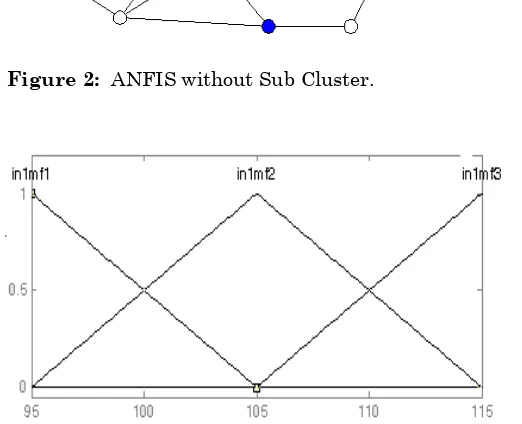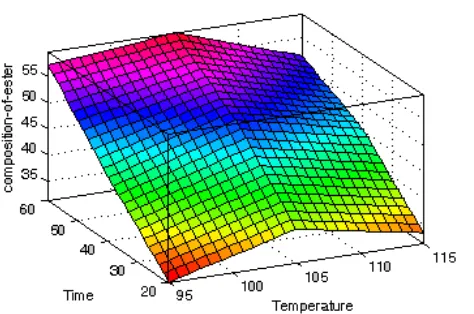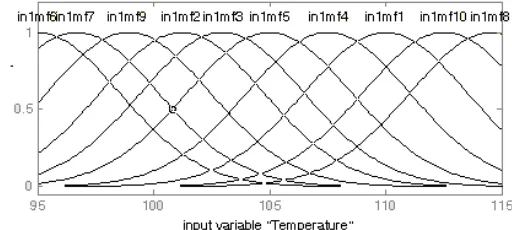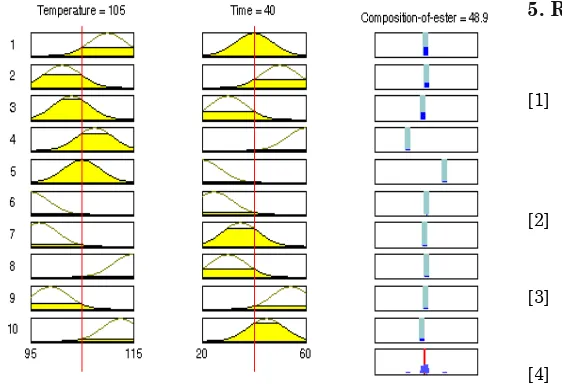1. Introduction
The search for eco- friendly fuel that have potential to substitute conventional oil in various industrial applications is currently being considered a top priority research topic. This emphasis is largely due to the rapid depletion of world fossil fuel reserves and increasing concern for environmental pollution from excessive mineral oil use and their disposal. Jatropha Curcas is promising non edible oil for the biodiesel production in developing countries of Asia. Biodiesel production from non edible oils takes place through different chemical reactions, but transesterification of vegetable oils with simple alcohol has long been a preferred method for
Fuzzy Modeling to Evaluate the Effect of Temperature on
Batch Transesterification of Jatropha Curcas for Biodiesel
Production
Vipan Kumar Sohpal 1 *, Amarpal Singh1, Apurba Dey2
1 Department of Chemical Engineering, Beant College of Engineering and Technology,
Gurdaspur, Punjab, India
2 Department of Bio Technology, National Institute of Technology, Durgapur,
West Bengal, India
* Corresponding Author.
E-mail:[email protected] (V.K. Sohpal), Tel: +91-98882-20918, Fax: +91-1874-221463
Bulletin of Chemical Reaction Engineering & Catalysis, 6 (1), 2011, 31 - 38
Received: 27th January 2011; Revised: 13rd February 2011; Accepted: 16th February 2011
Abstract
Biodiesel is an alternative source of fuel that can be synthesized from edible, non-edible and waste oils through transesterification. Firstly Transesterification reaction of Jatropha Curcas oil with butanol in the ratio of 1:25 investigated by using of sodium hydroxide catalyst with mixing intensity of 250 rpm in isother-mal batch reactor. Secondly the fuzzy model of the temperature is developed. Performance was evaluated by comparing fuzzy model with the batch kinetic data. Fuzzy models were developed using adaptive neuro-fuzzy inference system (ANFIS). © 2011 BCREC UNDIP. All rights reserved.
.
Keywords: Transesterification, Temperature, Jatropha Curcas oil, Chemical Kinetics and Fuzzy Modeling
producing biodiesel fuel. Munir et al. (2000) studied the kinetics of Palm oil transesterification in batch reactor. Methyl esters were produced by transesterification of Palm oil with methanol in presence of catalyst potassium hydroxide [14]. Ayhan studied waste cooking oil has subjected to transesterification reaction by potassium hydroxide (KOH) catalytic and supercritical methanol methods obtaining for biodiesel [1]. Fuduka et al. analyzed various methods of transesterification reaction for the production of biofuels [6]. Transesterification of Jatropha oil using supercritical methanol and in absence of a catalyst has been studied under different conditions of temperature ( 512 to 613 K), pressure (5.7 to 8.6 MPa) and molar ratio of alcohol to oil (from 10 to 43 mol alcohol per mol oil) studied by Hawash et al [8] . Kusdiana et al. studied the transesterification of rapeseed oil in sub critical and supercritical methanol under different
Available online at BCREC Website: http://bcrec.undip.ac.id
reaction conditions of temperatures and reaction times [10] and [11]. Houfang et al worked on two-step process consisting of pre-esterification and transesterification was developed to produce biodiesel from crude Jatropha curcas L. oil. .
The yield of biodiesel by transesterification was higher than 98% in 20 min using 1.3% KOH as catalyst and a molar ratio of methanol to oil 6:1 at 64 °C [9]. Fangrui et al. investigated that the stirring speeds exceeded the threshold requirement of mixing for NaOH–MeOH needed to mix the two phases subsequently [5]. Girdhar et al. synthesized of biodiesel via transesterification of Sunflower oil. They investigated in supercritical methanol and supercritical ethanol at temperatures range of (200–400 °C) at pressure of 200 bars [7]. Murugesana. et al. concentrated the prospects and opportunities of introducing vegetable oils and their derivatives as fuel in diesel engines for developing countries [15]. Noureddini.et al. studied the effect of mixing intensity on transesterification reaction. They used the different mixing intensity and investigate the effect of mixing on the kinetic behavior [16]. Matthew et al. investigated the kinetics of the biodiesel reaction in order to find out how best to reach 96.5% methyl ester [13]. Dongsheng et al. reviewed state-of-the-art application of the supercritical fluid (SCF) technique in biofuels production that includes biodiesel from vegetable oils via the transesterification process, bio-hydrogen from the gasification and bio-oil from the liquefaction of biomass, with biodiesel production as the main focus [4]. Sulaiman et al. developed a model to describe the system, taking into consideration the mass transfer resistances of the reactants [18].
Blahova et al. focused on municipal solid waste management systems. They studied the hybrid of wavelet transform-adaptive neuro-fuzzy inference system (WT-ANFIS) and wavelet transform-artificial neural network (WT-ANN) is used to predict the weekly waste generation [2]. Chaibakhsh et al. presented an application of a neuro-fuzzy modeling approach in order to characterize essential behavior of biological processes. There results expressed the accuracy and feasibility of proposed algorithm for optimization of biological processes [3]. Raymond et al presented a fuzzy multiple-objective modeling approach for determining optimal bio energy system configuration given targets for the three footprint metrics. The fuzzy optimization approach is integrated with an input–
output-based life cycle model for establishing system material and energy balances [17]. Li et.al proposed a novel integration of design and control for the nonlinear process under uncertainty. They observed proposed fuzzy method is better than traditional sequential method and an existing integration method on controlling the temperature profile of a nonlinear curing process [12].
In this paper the transesterification reaction is conducted in batch reactor to study the effect of temperature on kinetics of biodiesel production. Then fuzzy model of temperature is developed for batch transesterification process and results are validated with batch data analysis and simulate its performance
2. Experimental Method and Material
Jatropha Curcas oil from National Biofuel Corporation, New Delhi was used as the raw oil. The fatty acid composition was determined by Gas chromatography for removal of free fatty acid. Butanol purchased from SRL Chemical Ltd and Sodium hydroxide was purchased from Nice Chemical. Free fatty acid (FFA) converted to fatty acid butyl ester by an acid catalyzed pretreatment and in the second step transesterification completed by using alkaline catalyst (NaOH) to complete the reaction and moisture removed using extraction of Jatropha Oil. The batch transesterification reaction system was employed in this experimental work. A 1500 ml glass reactor equipped with mechanical stirrer, thermometer, condensing coil and sample port was used in all kinetic experiments. The reactor was immersed in constant temperature heating mental which was capable of controlling the temperature to within deviation of 50 oC .A mechanical stirrer fitted with stainless steel propeller provided the mixing requirement . Eighty seven reactions were carried out over the entire duration of experimental work. The conditions such as reactants, temperature, catalyst and mixing intensity, where varied to assess firstly the rate of reaction and secondly the best possible conditions.
Procedures:
(i) The reactor was initially charged with Jatropha oil depending upon the required molar ratio of oil to Butanol. The reactor assembly was then placed in constant heating mental and heated to the desired temperature.
to the reactor. Mechanical stirrer was started as per required temperature. The reaction was timed as soon as mechanical stirrer was turned on. (iii) During the experiment run the samples were drawn at 10 minutes of time interval. Approximately 6 to 7 samples were collected during the course of each reaction (60 minutes). (iv) Samples were collected in 10ml test tubes filled with 4ml of distilled water. The test tubes were kept in an ice bath at about 50 oC prior to use. (v) Samples of (2 ml) were quenched in the test tubes by placing them in the ice bath immediately after removal from glass reactor. The test tubes were then shaken to stop the reactions.
(vi) The different layers formed of glycerol, unreacted reactant and the products which were then centrifuged at 1600 rpm for 10-15 minutes to ensure a through separation.
(vii) Weigh out 50 mg of sample into a 10 ml hexane layer is collected for GLC analysis.
(x) Gas liquid chromatography (GLC) (Nucon GLC which consists of the diameter of column- DB-5 Column, Length 15 meter and internal diameter 32 mm) used to analyzed for its composition
3. Results and Discussion
3.1 Fuel Properties
The properties of biodiesel such as density, viscosity, iodine value, cloud point, flash point and acid value were measured according to standard methods (AOCS and ASTM). The densities of pure Jatropha Curcus oil and their biodiesel ester at 15 oC are arranged from lower to higher alcohols. The densities of ester were significantly lower than source oil and varied from 0.879 to 0.892 g/ml. For different alcohols, density and viscosity of esters increased with alkyl group such as methyl < ethyl < propyl < butyl. Iodine value is only dependent on the origin of vegetable oil, the biodiesel esters made from same oil showed similar iodine values. The higher value of iodine is due presence of linolenic acid (34% w/w) in Jatropha oil. Cloud point affects the flow behavior of fuel, higher alkyl group favour the flow properties of esters. Generally cloud point has range from 10 to 15 0C. Flash point after transesterification process is excellent and safe for transportation. Acid value of biodiesel varies from low 0.06 to 0.05 mg KOH/g for propyl and butyl esters to highest 0.24 for ethyl
ester of Jatropha Curcus.
3.2 Characterization of Biodiesel Product
Various analytical methods already developed for analyzing mixture containing fatty acid esters and mono, di and tri-glycerides obtained from the base catalyzed transesterification process. A gas chromatographic (GC) method is used for determination of biodiesel products and by-product. Column DB-5 (30 m x 0.53 mm I.D, 1.5
μm) at condition of (Carrier Helium gas at 48.5 cm/sec, measured at 60 °C, Oven: 60 °C for 2 min 60-300 °C at 12 °/min, 300 °C for 10 min, Injector Direct at 280 °C, 1μL injection in hexane Detector: FID, 250 °C and nitrogen makeup gas at 30 mL/min) allows the determination of all analytes in single GC run. Starting from the crude oil, which has a high value of triglycerides (depend upon the plantation environment) converted into butyl ester. Lower amount of water present in crude oil is highly suitable for product formation. The concentration of Phosphorus, Calcium and Magnesium reduced significantly after transesterification, which meets the environment standard.
Bulletin of Chemical Reaction Engineering & Catalysis, 6 (1), 2011, 33
Table1 Characterization of Biodiesel products
3.3 Effect of Reaction Temperature
Previous experiment has revealed that rate of reaction increase with temperature of reactions. Experiments were performed over the temperature range of 95 to 115 °C to examine the effect of temperature on the triglycerides for the synthesis of biodiesel at 1:25 Jatropha oil: Butanol molar ratio with 30 g of NaOH catalyst Figure 1 transesterification reaction was found to continuously increase with increase in temperature, with a maximum conversion at 105 °C. The activation energy was calculated from the slope was equal to -E/R. In the present reaction, the apparent activation energy was 157.73 cal. (mole .K)-1
3.4 Fuzzy Modeling using ANFIS on Product Formation without Sub clustering
The modeling of the system has been done using adaptive neuro fuzzy inference system (ANFIS) by considering the two input parameters and one output variable. Temperature of reaction (Temperature 0C) and Time of the reaction (Time) are input variables and output as composition of Butyl Ester (%w/w) using mamdani. This technique provides procedure to learn information about a data set, in order to compute the membership function parameters that best allow the associated fuzzy inference system to track the given input/output data. The data used for modeling in ANFIS method basis of experimental
Bulletin of Chemical Reaction Engineering & Catalysis, 6 (1), 2011, 34
result. Out of 25 runs 10 are used to train the ANFIS and 15 are used to evaluate the fuzzy system. ANFIS without sub cluster is shown in Figure (2). Figure (3) and Figure (4) shows input membership functions of Temperature and Time for the model. Figure (5) indicates the output membership function of composition of ester (% product). Here the model makes use of nine rules. Set of linguistic rules for fuzzy model without sub clustering are given below:-
If (Temperature is mf1) and (Time is mf1) then (Composition of ester out mf1)
If (Temperature is mf1) and (Time is mf2) then (Composition of ester out mf2)
If (Temperature is mf1) and (Time is mf3) then (Composition of ester out mf3)
If (Temperature is mf2) and (Time is mf1) then (Composition of ester out mf4)
If (Temperature is mf2) and (Time is mf2) then
Figure 1 Effect of Temperature on biodiesel production. Reaction conditions: 1:25 oil to butanol molar ratio, 30 gm of NaOH catalyst and 250 rpm
Figure 2: ANFIS without Sub Cluster.
(Composition of ester out mf5)
If (Temperature is mf2) and (Time is mf3) then (Composition of ester out mf6)
If (Temperature is mf3) and (Time is mf1) then (Composition of ester out mf7)
If (Temperature is mf3) and (Time is mf2) then (Composition of ester out mf8)
If (Temperature is mf3) and (Time is mf3) then (Composition of ester out mf9)
Figure 6 indicates rule viewers that shows value of the various inputs to the model and computed outputs. The composition of esters (output) can be predicted by varying the input parameters temperature and time to the developed fuzzy model. For a particular instance, set of input values given to the model is 105 0C and 40 minutes of reaction. The output generated by the model; composition of ester (% product) is 50.8 (%w/w) near to kinetic data as shown in Figure 1. Similarly Figure 7 reveals the composition of ester
as function of temperature and time in three dimensional patterns.
3.5 Fuzzy Modeling using ANFIS on Product Formation with Sub clustering
Variables for fuzzy model have already been identified as Temperature of reaction (0C) and time required for reaction (Time) which is taken as input parameters and composition of ester (% product) is selected as output parameter of the integrated fuzzy model. Universe of discourses for input parameters are 95 to 115 0Cand 20 minutes to 60 minutes respectively. The membership functions have been selected such that linguistic variables show suitable coverage on the universe of discourse.
Figure (8) shows ANFIS with sub cluster. Figure (9) and Figure (10) shows input Bulletin of Chemical Reaction Engineering & Catalysis, 6 (1), 2011, 35
Figure 4: Input Membership Function Time (Minutes)
Figure 5: Output Membership Function (Composition of Esters)
Figure 6: Rule viewer without Sub Clustering (Temperature, Time, and Composition of Esters)
membership functions of Temperature and Time for the model. Figure (11) indicates the output membership function of composition of ester (% product) varies with temperature and time. Here the model makes use of ten rules. Set of linguistic rules for fuzzy model with sub clustering are given below:-
If (Temperature is mf1) and (Time is mf1) then (Composition of ester out mf1)
If (Temperature is mf2) and (Time is mf2) then (Composition of ester out mf2)
If (Temperature is mf3) and (Time is mf3) then (Composition of ester out mf3)
If (Temperature is mf4) and (Time is mf4) then (Composition of ester out mf4)
If (Temperature is mf5) and (Time is mf5) then (Composition of ester out mf5)
If (Temperature is mf6) and (Time is mf6) then (Composition of ester out mf6)
If (Temperature is mf7) and (Time is mf7) then (Composition of ester out mf7)
If (Temperature is mf8) and (Time is mf8) then (Composition of ester out mf8)
If (Temperature is mf9) and (Time is mf9) then (Composition of ester out mf9)
If (Temperature is mf10) and (Time is mf10) then (Composition of ester out mf10)
Figure (12) shows the rule viewers for the temperature with sub-clustering for temperature of reaction 105 0C and time of 40 minutes. The output composition of ester (% product) in this case is 48.9 which matched the value obtained by experimental kinetic data analysis.
Bulletin of Chemical Reaction Engineering & Catalysis, 6 (1), 2011, 36
Figure 8: ANFIS with Sub Cluster.
Figure 9: Membership Function Plot for Input Variable Temperature (0C)
Figure 10: Membership Function Plot for Input Variable Time (Minutes)
Bulletin of Chemical Reaction Engineering & Catalysis, 6 (1), 2011, 37
4. Conclusion
The result obtained from experimental data and fuzzy modeling is very similar. Both techniques are very efficient and accurate. It is observed that in batch operation rise in the temperature of reaction increased the rate constant value with respect to time, which suggests that reaction equilibrium towards forward direction. Fuzzy systems provide a more transparent representation of the process parameter and output without clustering and with sub-clustering near to experimental result In addition of that it give a linguistic interpretation in the form of rules. The rules extracted from data can be validated by experts, and combined with their prior knowledge to obtain a complete system model describing the reality over the entire domain of interest.
5. References
[1] Kalogirou, M.; Pistikopoulos, P.; Ntziachristos, L.; and Samaras, Z. 2009. Isothermal soot oxidation experiments with intermediate gas change in a perkin-elmer TGA6. J. Therm. Anal. Cal. 95: 141–147.
[2] Lloyd, A.C.; and T.A. Cackette. 2001. Diesel Engines: Environmental Impact and Control. J. Air & Waste Manage. Assoc. 51: 809-847.
[3] Walker, A.P. 2004. Controlling particulate emissions from diesel vehicles: A Review. Topics in Catal 28: 165-170.
[4] Stamatelos, A.M. 1997. A review of the effect of particulate traps on the efficiency of vehicle diesel engines.Energy Convers. Mgmt. 38: 83-99.
[5] Fino, D. 2007. Diesel emission control: A review of catalytic filters for particulate removal. Sci. & Technol. of Adv. Materials 8: 93-100.
[6] Lopez-Fonseca, R.; Elizundia, U.; Landa, I.; Gutie´rrez-Ortiz, M.A.; Gonza´lez-Velasco, J.R. 2005. Kinetic analysis of non-catalytic and Mn-catalysed combustion of diesel soot surrogates.
Appl Catal B 61: 150–158.
[7] Van Setten, B.A.A.L.; Schouten, J.M.; Makkee, M.; Moulijn, J.A. 2000. Realistic contact for soot with an oxidation catalyst for laboratory studies.
Appl. Catal. B 28: 253-257.
[8] Pierre Darcy, Patrick Da Costa, Henry Mellotte,Jean-Michel Trichard, Gerald Djega-Mariadassou. 2007. Kinetics of catalyzed and non-catalyzed oxidation of soot from a diesel engine. Catal. Today. 119: 252–256.
[9] Stanmore, B.R.; Brilhac, J.F.; Gilot, P. 2001. The oxidation of soot: a review of experiments, mechanisms and models. Carbon 39: 2247–68.
[10] Dernaika, B.; Uner, D. 2003. A simplified approach to determine the activation energies of uncatalyzed and catalyzed combustion of soot.
Appl. Catal. B 40: 219-229
[11] Illekova, E.; and Csomorova, K.2005. Kinetics of
oxidation in various forms of carbon. J. Therm.
Anal. Cal. 80: 103-108.
[12] Lopez-Fonseca, R.; Landa, I.; Gutierrez-Ortiz, M.
A.; and Gonzalez-Velasco, J. R. 2005. Non- isothermal analysis of the kinetics of the combustion of carbonaceous materials, J. Therm. Anal. Cal.80: 65-69.
[13] Mianowski, A.; Bigda, R. ; and Zymla, V. 2006. Study on kinetics of combustion of brick-shaped carbonaceous materials. J. Therm. Anal.Cal. 84: 563-574.
[14] Neeft, J.; Hoornaert, F. ; Makkee, M.; and Moulijn, J. A.1996. The effects of heat and mass transfer in thermogravimetrical analysis. A case study towards the catalytic oxidation of soot. Thermochim. Acta, 287: 261-278.
[15] Stratakis, G. A.; and Stamatelos, A. M. 2003. Thermogravimetric analysis of soot emitted by a modern diesel engine run on catalyst-doped fuel. Combust. Flame. 132: 157-169.
[16] Yezerets, A.; Currier, N. W.; and Eadler, H. A. 2003. Experimental Determination of the Kinetics of Diesel Soot Oxidation By OD2 - Modelling
Consequences. SAE technical paper,
2003-01-0833.
[17] Messerer, A.; Niessner, R.; and Poschl, U. 2006. Comprehensive kinetic characte- rization of the oxidation and gasification of model and real diesel soot by nitrogen oxides and oxygen under engine exhaust conditions: Measurement,
Langmuir-Hinshelwood, and Arrhenius parameters. Carbon
44: 307-324.
[18] Ahlstrom, A. F. and Odenbrand, C. U. I. Combustion characteristics of soot deposits from diesel engines.Carbon 1989, 27, 475-483.



